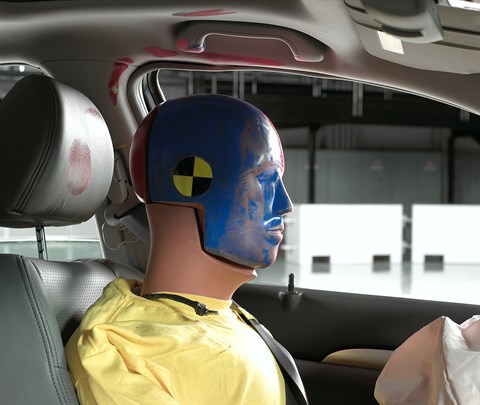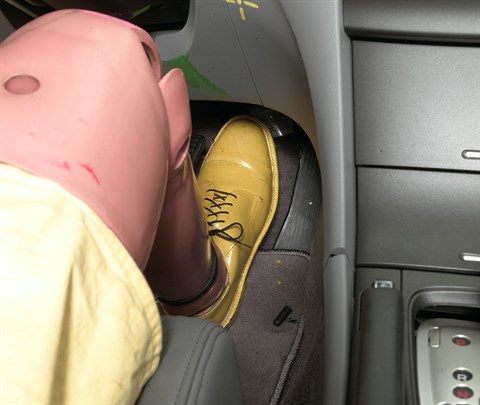Moderate overlap front: original test
Rating applies to 2004-08 models
Tested vehicle: 2004 Acura TSX 4-door
The Acura TSX was introduced in the 2004 model year.
| Overall evaluation | |
|---|---|
| Structure and safety cage | |
| Driver injury measures | |
| Head/neck | |
| Chest | |
| Leg/foot, left | |
| Leg/foot, right | |
| Driver restraints and dummy kinematics |

Action shot taken during the frontal offset crash test.

The energy of the crash was absorbed by the front end of the car, preserving the driver's survival space very well.

Smeared greasepaint indicates where the dummy's head contacted the B-pillar, roof rail, grab handle, and head restraint during rebound. Head accelerations from these hits were low.

Forces on the lower right leg were high enough to indicate the possibility of injury.
Measures of occupant compartment intrusion on driver side
| Test ID | CEF0405 |
|---|---|
| Footwell intrusion | |
| Footrest (cm) | 6 |
| Left (cm) | 8 |
| Center (cm) | 9 |
| Right (cm) | 6 |
| Brake pedal (cm) | 6 |
| Instrument panel rearward movement | |
| Left (cm) | 0 |
| Right (cm) | 0 |
| Steering column movement | |
| Upward (cm) | 4 |
| Rearward (cm) | -1 |
| A-pillar rearward movement (cm) | 0 |
Driver injury measures
| Test ID | CEF0405 |
|---|---|
| Head | |
| HIC-15 | 179 |
| Peak gs at hard contact | 19 |
| Neck | |
| Tension (kN) | 1.0 |
| Extension bending moment (Nm) | 9 |
| Maximum Nij | 0.25 |
| Chest maximum compression (mm) | 28 |
| Legs | |
| Femur force - left (kN) | 0.2 |
| Femur force - right (kN) | 3.1 |
| Knee displacement - left (mm) | 0 |
| Knee displacement - right (mm) | 0 |
| Maximum tibia index - left | 0.30 |
| Maximum tibia index - right | 0.99 |
| Tibia axial force - left (kN) | 2.0 |
| Tibia axial force - right (kN) | 4.6 |
| Foot acceleration (g) | |
| Left | 75 |
| Right | 55 |
Head restraints & seats
Seat type: All seats
| Overall evaluation | |
|---|---|
| Dynamic rating | |
| Seat/head restraint geometry |
| Seat type | All seats |
|---|---|
| Geometry | |
| Backset (mm) | 65 |
| Distance below top of head (mm) | 52 |
| Seat design parameters | |
| Pass/fail | Fail |
| Max T1 acceleration (g) | 10.5 |
| Head contact time (ms) | 105 |
| Force rating | 3 |
| Neck forces | |
| Max neck shear force (N) | 175 |
| Max neck tension (N) | 1,253 |
About the head restraint & seat test
Currently, IIHS tests apply only to front seats.
